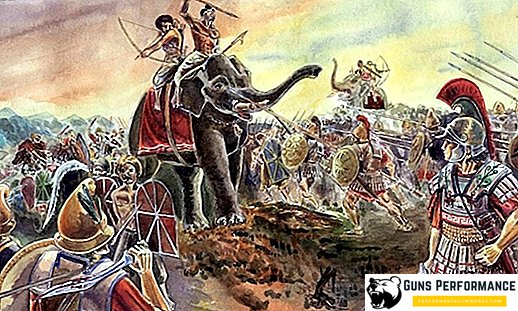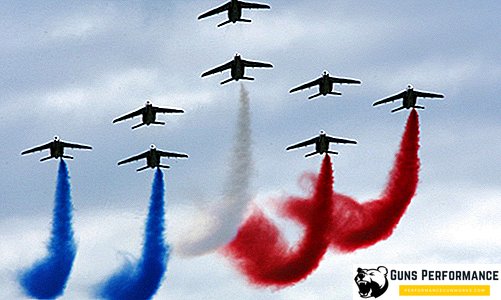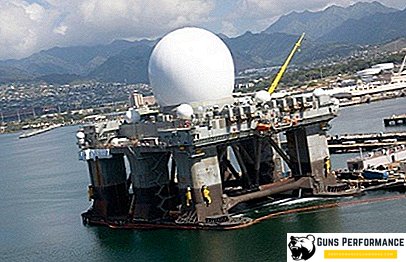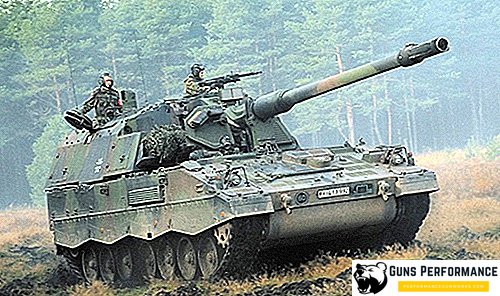The President of Pakistan is elected for 5 years, according to the Constitution of the country. The head of government is chosen in an entirely traditional way: he is elected by a special electoral college consisting of members of the Senate, deputies of the National Assembly and members of parliament in four provinces. One person can hold the presidency of Pakistan for two consecutive terms, but no more. The country's legislation provides for an impeachment procedure, which ends with the resignation of the head of state. To this end, 2/3 of the parliament must vote against the leader of the country.
As for the status of the president, according to the traditions established since 1947, when India was divided into two states, the real power in the country belongs to the Prime Minister, although the head of state is the Supreme Commander of the armed forces of Pakistan.
Brief history of the state before the conquest of the region by British troops

In the 4th century BC, troops of Alexander the Great invaded the territory of modern Pakistan and India. Local residents, led by King Porom, gave the conquerors a battle, but lost. After this, the country became part of the empire of Alexander the Great. After that, the country was conquered several times and changed its rulers:
- After the collapse of the Macedonian Empire, the country became part of the Mauryan Empire;
- Then the territories of modern Pakistan were conquered by the Greeks, who founded the Indo-Greek kingdom. It lasted until the year 10 n. er;
- Gradually, the Scythians ousted the Greeks and conquered the territories of India and Pakistan, establishing the Indo-Scythian kingdom. It lasted until the year 400;
- Simultaneously with the last kingdom, the Kushan kingdom existed in the territories of northern India;
- After that, the Sassanid Empire, the Ephtalits and the Gupta fought for power in the region.
Until the beginning of the VIII century, all the conquerors gradually assimilated with the local population. In the 8th century, Islam began to spread in the territories of modern Pakistan, which was brought by the warriors of the famous Arab commander Ibn Qasim. Over time, he conquered the entire territory of modern southern Pakistan, which became part of the Arab Caliphate. Unlike other conquerors, the Arabs actively propagated Islam in the occupied territories.
In the XI century, Mahmud of Ghaznavi, the padishah of the Ghaznavid dynasty, made more than 17 conquests to northern India, expanding the boundaries of his kingdom. After 100 years, the city of Lahore became the center of the Sultanate of the Ghurids, who gradually conquered the central regions of India. After some time there was created Delhi Sultanate. In the XVI century, the entire territory of modern Pakistan entered the Mughal Empire. Pashtun-surids constantly fought against them, who wanted to seize power in the region. Toward the 18th century, powerful feudal states emerged in the territories of India and Pakistan:
- In Punjab;
- Sind;
- Balochistan.
The largest powers at that time were the Durrani Empire and the Sikh State. In the XIX century, the entire territory of modern Pakistan was captured by British troops, after which it became part of British India.
Dominion Pakistan and the development of the Islamic Republic until 1990

In July 1947, the British Parliament adopted a decree on the independence of India, the main purpose of which was to divide the country into Dominion Pakistan and India. The name "Pakistan" embodies the spirit of the Muslim population of the region, because "Paki" means true or pure. Bangladesh entered the Dominion State of Pakistan, but Kashmir fell under the rule of India, as the Maharajah Hari Singh, a Hindu, ruled there. Despite this, about 77% of the subjects of the Maharajah were Muslims. They revolted against their ruler, as a result of which they formed the Free Kashmir state, which became part of Pakistan. The main task of India was the return of the territories of Kashmir, so the conflict broke out, which lasted until 1949, called the First Indo-Pakistani war.
The first ruler of the Dominion of Pakistan was Muhammad Ali Jinn, who was the governor-general. Having taken this post in 1947, Jinna died a year later from tuberculosis and lung cancer. The next ruler of Pakistan was Governor-General Khawaja Nazimuddzin. He ruled the country until 1951, in which Pakistan declared its independence from the British Crown. The third governor-general of Pakistan was Ghulam Muhammad. Despite declaring the country's independence, the UK still rules it. The advocates of independence tried to change this situation:
- The Constituent Assembly was assembled, which was to develop its own algorithm for governing the state;
- In 1954, the assembly was dissolved, because the British did not need an independent Pakistan. The formal reason for the dissolution was the threat of Indian separatists who operated in the east of the country;
- In 1955, the Second Constituent Assembly was convened, which was able to liberate the country from the influence of Great Britain.
In 1956, Pakistan became a fully independent state. He became known as the Islamic Republic of Pakistan. The first president of the new state was Iskander Mirza, whose inauguration took place in 1956. The status of the head of state remains the same as that of the governor-general, only the name of the position has changed.
The first president of the country was an excellent politician. By his orders, he tried to balance the balance of political forces in the country. In order to reduce the influence of the Muslim League, he created the Republican Party of Pakistan. Since the head of state was well aware of the power of religious leaders in the country, he tried to reduce their influence on the political situation. In 1958, Iskander Mirza abolished the 1956 Constitution and dissolved Parliament. At the same time, he appointed Pashtun Mohammed Ayub Khan to be the commander-in-chief of the country's armed forces. But he committed a military coup and forced the president to leave the country.
After declaring himself the new head of state, Ayub Khan ceased activity of various political parties, and initiated the creation of the 1962 Constitution, in which the power of the president was greatly strengthened. In 1969, Ayub Khan was forced to resign, as he could no longer control the situation in the country due to a long and serious illness. During the reign of this leader in the country, the Second Indo-Pakistani War occurred.
In 1969, the presidency was occupied by another Pakistani general, Yahya Khan. Unlike other Pakistani rulers, the general did not want to hold the presidency for a long time. Already in 1970, he began to look for an opportunity to shift his powers to another person. Yahya Khan presented his version of the interim Constitution to the government, and in 1970 the first general elections were held in Pakistan. The president constantly sought to settle problems in the state peacefully, but in the end this led to a political split, and the Third Indo-Pakistani war. Since Pakistan’s troops were defeated, Yahya Khan, who was overthrown in 1971, was found guilty.
The next head of state was Zulfikar Ali Bhutto. Made for the country the following:
- Dropped Pakistan out of British Commonwealth membership;
- Agreed with Indira Gandhi on the withdrawal of Indian troops from the border;
- Adopted a new constitution in 1973;
- He made the power of the President of Pakistan purely formal, after which he immediately took the post of Prime Minister, who had real power in the country.
In 1977, a military coup took place in the country, as a result of which Muhammad Zia-ul-Haq came to power. He accused the previous prime minister of the assassinations of his political opponents and put him on trial, which decided to execute Zulfikar Bhutto. Zia-ul-Haq was a supporter of the Islamization of Pakistan, at the same time he tried to build political relations with the United States of America. The Soviet-Afghan war accelerated the process of rapprochement of the country with the United States, since Pakistan was on the side of Afghanistan against the USSR. In 1988, the country's president was killed in a plane crash. Some believe that the Soviet Union was directly involved in it.
The next head of state was Ghulam Iskhak Khan, who was previously the chairman of the Senate. With him, Pakistan achieved the following successes:
- There has been a democratization of society;
- The opposition has received many rights and opportunities to influence the political situation in the country;
- Normalized relations with India.
There were also negative changes in Pakistan. For example, corruption at the government level was open. From investors demanded 10% of transactions, because of what the people got the government nickname "government ten percent." In 1990, the president was forced to dismiss the entire government. He himself left the presidency in 1993, as he could not find a common language with the new government.
Presidents of Pakistan in the 90s and in the XXI century

In 1993, Farooq Leghari became President of Pakistan. The prime minister with him was Benazir Bhutto. Under her, corruption in Pakistan reached unprecedented heights. In 1996, the president was forced to dismiss Bhutto from his post, at the same time disbanding the entire government. The next prime minister was Sharif, who immediately began to fight with President Legari. He adopted amendments to the Constitution, thanks to which the head of Pakistan lost the right to dismiss the government.
Despite all the reforms undertaken by the head of state, Legari was forced to resign in 1997. The next president of the country was Rafik Tarar, who remained at his post until 2001. The new president was not burdened with responsibilities, since all power was concentrated in the hands of Prime Minister Sharif. Fearing for his position, the prime minister dismissed army commander Musharraf, who had great power in army circles. As a result of this, the military responded instantly, and carried out a coup in the country. The prime minister was arrested by order of the president and sentenced to life imprisonment. However, thanks to a bribe, this measure of punishment was soon replaced by expulsion to Saudi Arabia.
Presidents of Pakistan in the 21st Century

Pervez Musharraf (reign 2001-2008) was elected president of Pakistan for two consecutive terms. The new head of state promised people to end corruption, which he tried to accomplish. The power of the president was based on the fact that he was at the same time the head of the armed forces. In a second election in 2007, the Supreme Court refused to recognize Masharraf as president, unless he resigned as commander-in-chief of the army. Because of this, the head of state had to leave military service in the same year, on the basis of riots in the country. In 2008 he was forced to voluntarily resign.
The next head of Pakistan was Asif Ali Zardari. He ruled from 2008 to 2013. After his election, the following important events occurred in the country:
- A transition to a parliamentary republic was promised, by reducing the role of the president in government;
- Zardari officially denied that Pakistan assists Islamic terrorists, which caused Al Qaeda’s negative reaction;
- Nawaz Sharif tried to raise a rebellion against the head of state, but it was brutally suppressed;
- In 2011, Osama bin Laden's No. 1 terrorist was liquidated in Pakistan, which worsened relations with the United States.
To protect himself from possible rallies and protests, the president issued a law according to which any joke, insult or anecdote about the head of state is a crime punishable by up to 14 years in prison.
Currently, Pakistan’s president is Mamnun Hussein, who has held this post since 2013.
The constitutional features of Pakistan, the duties of the president of the country

At present, Pakistan is a federal republic of presidential-parliamentary type. The basic law of the country is the Constitution of 1973, according to which Pakistan is an Islamic republic. Only a Muslim who is 45 years old can be President of the country. Although the head of state has many powers, the main person involved in government should be the prime minister, who is the head of government. Elected by a prime minister in the parliament.
From 1979 to 1985, the Constitution of Pakistan was suspended. In 1985, another amendment was issued, after which the Constitution was re-launched. It was revised, with the result that the president received the following rights:
- The head of state became the supreme commander of the armed forces, the head of the executive branch, a direct part of the legislative branch;
- The president’s dependence on prime ministers has disappeared;
- The head of Pakistan was able to dissolve the lower house of parliament, to appoint new special elections;
- Conduct referendums;
- To appoint and approve applicants for the highest military posts in the country.
In this form, the Constitution worked until 1997, after which a new amendment was adopted, largely negating the 1985 amendment. The president once again lost his expanded powers, and the prime minister again became a key figure in the state.
In 2003, in accordance with a presidential decree, the 17th Amendment to the Constitution of Pakistan was adopted. After that, the head of state again received a number of powers, taken from him in 1997. Now all amendments to the country's Constitution should be adopted according to the following algorithm:
- The initiator can be any of the chambers of parliament;
- For this, 2/3 of the deputies of the chamber must vote;
- After that, the amendment is sent to the other house of parliament, where it must also receive approval of 2/3 of deputies;
- After that, the bill is sent for signature to the president, who can supplement it or refuse to sign it.
Thus, at present, the head of state has a great influence on the political arena, both within the country and abroad.
The role of military and security forces in the management of Pakistan

Based on the situations that took place at the end of the 20th and the beginning of the 21st century, it can be seen that the military elite has a great influence on the state policy. The army is able to accomplish a military coup in the country in a short period of time, which has already been repeatedly demonstrated. The commanders of the Pakistani armed forces became presidents 4 times:
- In 1958, General Ayub Khan came to power;
- In 1969, he handed over the reins to his predecessor, General Yahya Khan;
- In 1977, thanks to a military coup, General Zia-ul-Haq became president;
- In 1999, General Musharraf came to power.
The military government dealt harshly with the opposition and the rule of Pakistan with an iron fist. Until now, the military elite has enormous influence in the region, since the army can dictate its conditions from a position of strength. In addition to the armed forces, the following special services and forces are influencing the country:
- United Military Intelligence;
- Military intelligence;
- Federal Investigation Agency;
- Ministry of the Interior.
Police and other paramilitary units can also influence the political situation in the country.
The role of religious leaders in the governance of the Islamic State of Pakistan

According to the Constitution, Islam is the state religion of Pakistan. The state must provide all its citizens with the necessary conditions to comply with all the fundamental principles of religion. Also in the country's Constitution, it is stipulated by law that Pakistan is obliged to maintain fraternal and friendly relations with other countries of the Muslim world. This is what caused al-Qaida aggression against President Zardari, who did not support Islamic terrorists.
All laws that are adopted by the president and parliament must comply with the prescriptions of Islam. This is also enshrined in the country's Constitution. The fulfillment of these requirements is monitored by a special Council of Islamic ideology. Участие религиозных деятелей ислама в политике государства отражается через огромное количество различных религиозных партий и организаций, которые существуют в стране.
Около 3/4 всех мусульман, проживающих на территориях Пакистана, являются представителями суннизма ханафитского толка. Около 20% жителей являются шиитами. Менее 4% местных граждан являются ахмадийцами, они не причислены к мусульманам. Когда к власти в Пакистане пришёл генерал Зия-уль-Хака, он решил подвергнуть исламизации все сферы гражданского общества. Таким образом, президент боролся с оппозицией.
Резиденция президента Пакистана

В настоящее время официальной резиденцией главы страны является Айван-е-Садр. Данное здание расположено недалеко от парламента Пакистана. Строительство резиденции было завершено в 1988 году, когда главой государства был Гулам Исхак Хан. Президент Первез Мушарраф не использовал резиденцию по назначению, так как он располагался в Доме Армии, а вот Асиф Али Зардари переехал в Айван-е-Садр ещё до своей инаугурации. Там же была расположена приёмная президента. Во время волнений и антиправительственных восстаний здание практически не пострадало.












